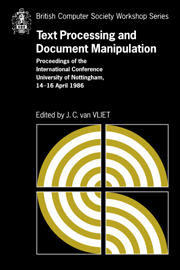 Text Processing and Document Manipulation
Text Processing and Document Manipulation Book contents
- Frontmatter
- Contents
- Preface
- The Design of Lucida®: an Integrated Family of Types for Electronic Literacy
- Tabular Typography
- A Simple Mechanism for Authorship of Dynamic Documents
- VORTEXT: VictORias TEXT reading and authoring system
- An Approach to the Design of a Page Description Language
- Intelligent Matching and Retrieval for Electronic Document Manipulation
- A Disciplined Text Environment
- Semantic Guided Editing: A Case Study On Genetic Manipulations
- Trends and Standards in Document Representation
- Textmaster – document filing and retrieval using ODA
- Combining Interactive Document Editing with Batch Document Formatting
- Formatting Structure Documents: Batch versus Interactive?
- Advanced Catalogue Production at Unipart
- Legibility of Digital Type-fonts and Comprehension in Reading
- An Overview of the W Document Preparation System
- Grif: An Interactive System for Structured Document Manipulation
- Procedural Page Description Languages
- A Strategy for Compressed Storage and Retrieval of Documents
- CONCEPT BROWSER: a System for Interactive Creation of Dynamic Documentation
- An Integrated, but not Exact-Representation, Editor/Formatter
- An Annotated Bibliography on Document Processing
- Systems used
An Overview of the W Document Preparation System
Published online by Cambridge University Press: 05 May 2010
- Frontmatter
- Contents
- Preface
- The Design of Lucida®: an Integrated Family of Types for Electronic Literacy
- Tabular Typography
- A Simple Mechanism for Authorship of Dynamic Documents
- VORTEXT: VictORias TEXT reading and authoring system
- An Approach to the Design of a Page Description Language
- Intelligent Matching and Retrieval for Electronic Document Manipulation
- A Disciplined Text Environment
- Semantic Guided Editing: A Case Study On Genetic Manipulations
- Trends and Standards in Document Representation
- Textmaster – document filing and retrieval using ODA
- Combining Interactive Document Editing with Batch Document Formatting
- Formatting Structure Documents: Batch versus Interactive?
- Advanced Catalogue Production at Unipart
- Legibility of Digital Type-fonts and Comprehension in Reading
- An Overview of the W Document Preparation System
- Grif: An Interactive System for Structured Document Manipulation
- Procedural Page Description Languages
- A Strategy for Compressed Storage and Retrieval of Documents
- CONCEPT BROWSER: a System for Interactive Creation of Dynamic Documentation
- An Integrated, but not Exact-Representation, Editor/Formatter
- An Annotated Bibliography on Document Processing
- Systems used
Summary
ABSTRACT
This paper describes both the use and the implementation of W, an interactive text formatter. In W, a document is interactively defined as a hierarchy of nested components. Such a hierarchy may be system- or user-defined. The hierarchy is used both by the W full-screen editor, and by the W formatting process, absolving the user from providing any layout commands as such. W manipulates text, such non-text items as mathematical formulae, and has provision for the inclusion of general graphical items.
Introduction
W is an interactive text-editor and document preparation facility being developed within the department of Computer Science at Manitoba. A working prototype of W, known as W-p, has been described elsewhere [King84]. W is a considerable development of that earlier system, but retains the same basic philosophy:
W is an interactive, extensible, integrated editor and formatter;
W adheres as closely as possible to the “what you see is what you get” (wysiwyg) philosophy;
W encompasses a wide range of document items, incuding text, tables, mathematical formulae, and provision for general graphical items;
W is portable and adaptable; that is, several versions of W are being produced to run on different architectures; although the user interface will differ in its detail, the underlying system will be common;
W is user extensible in a variety of ways.
The remainder of this paper is organised as follows. Section 2 describes W from the user's viewpoint and gives some details of its implementation. For the most part, it is a review of material which is covered in greater depth in [King84].
- Type
- Chapter
- Information
- Text Processing and Document ManipulationProceedings of the International Conference, University of Nottingham, 14-16 April 1986, pp. 188 - 199Publisher: Cambridge University PressPrint publication year: 1986


